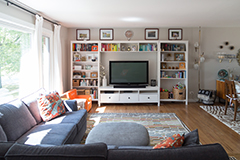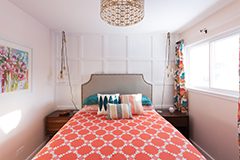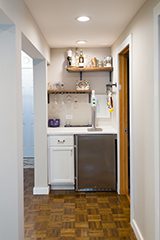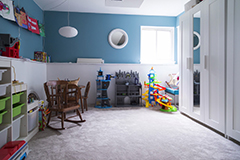I think most people in the house-blog world knows about the Nester and her window mistreatments. While they are lovely, I generally do not POUF, SWAG, TIE-BACK, FRINGE, or VALANCE my windows and window treatments. I prefer simple long panels, with only a couple exceptions (like my bathroom). I thought it couldn't be that hard to make my own simple 'curtain' panels. I put curtain in quotes because the only thing curtain-like about these is the fact that they hang in front of my windows. There are no rod pockets, grommets, or stitches in these bad boys. Here are the steps I took to make them:
Step 1 - Measure that fabric
I laid out the entire length of fabric to make sure I had enough for what I wanted to do. The lady at the store said 10 yards, but I wanted to be sure. Max held down the far end for me while I measured. How sweet.
I had exactly 30 feet of fabric. 30 feet = 360 inches = four 90 inch panels. Perfecto!
Step 2 - Cut it up
I measured out my first 90 inch section and cut...
and measured 90 inches and cut...well, you get the idea. I cut out four 90 inch lengths.
Step 3 - Do Nothing
Ok, that is not an actual step, but that is what I did after I cut everything. Here are my panels chilling out for a day in the dining room until I finally brought them upstairs:
Step 4 - Develop a deep, meaningful relationship with your iron
When you are unable to sew like me, you use the most wonderful invention ever made - Stitch Witchery! I got a double pack to have enough to go around all those edges. Then I used a handy little tool from the fabric store to measure my 'flap' that the iron-on webbing tape would slip into. The tape I got was 5/8 inches, so I measured the seam all the way down and ironed it flat. I also ironed the entire panel because no one likes displaying wrinkly curtains on their blog! TIP - sticking some straight pins right into the ironing board works great for holding down your seam before you iron it.
I started with the long sides because those were the narrowest hems. After the fold was created, I slipped the webbing in there and ironed again. And no fair looking at my dirty bathroom.
Hoodie hoo! After taking this picture, I was all excited that I did it! Then I realized I'd only completed 22 inches out of 1100. Moving on...Step 5 - Iron some more
After the long sides were done, I turned everything clockwise and started on the top of the panels.
Because my fabric was 90 inches long, and my curtains couldn't be longer than 85 inches to fit properly, I knew I would have a lot to hem on the top and bottom. For the top, I chose 3 inches and measured with my tool all the way down. Or until I got tired of measuring and just eye-balled it. Whatever rocks your socks.
Then I ironed the seam flat, placed the webbing as close to the open end as I could, and ironed again. You can also leave the short 'sides' open and leave room for a rod if you want a 'pocket,' however I prefer rings for their ease of opening and closing, so I used the webbing on the short sides to make it stiff and hang nicer.
Step 6 - Measure again before hemming the bottom of the panel!
I say this because I messed up the second one. I still don't know how, but the second panel was shorter than the first, even though it started out the same length and I thought I'd hemmed the same amount on both ends. It's a mystery, like socks disppearing in the dryer and the Kardashians getting a tv show. Either way, I just reheated the webbing and pulled it apart to fix and redo. Problem solved!
Aaaand, you're done! Clip your clean-edged fabric rectangle to your rings and then spend a few minutes just pulling them back and forth, admiring your work. Then go have some wine, because you deserve it! And then go look throughout your entire house to see what else you can hem or glue together with this amazing stuff!



.jpg)
.jpg)
.jpg)
.JPG)
.JPG)


.JPG)














